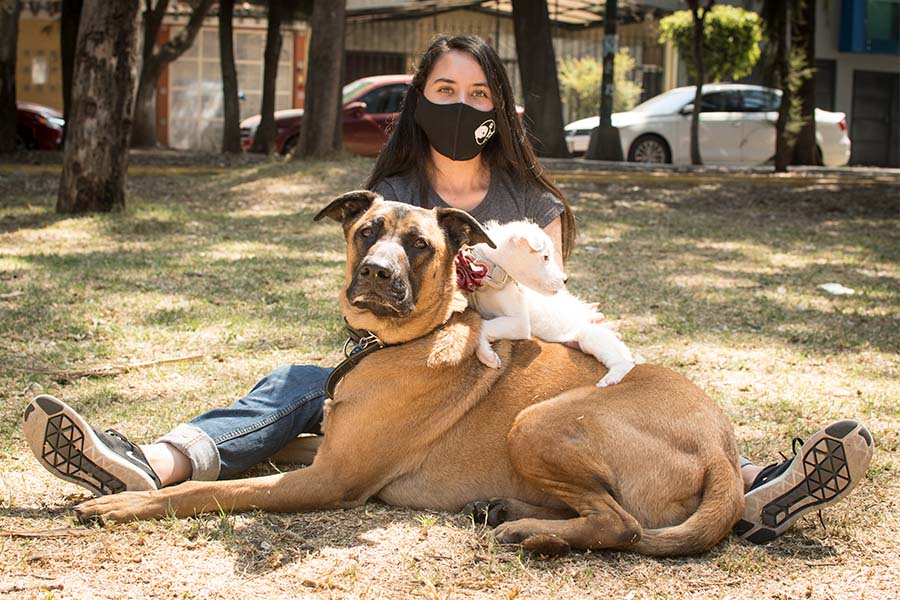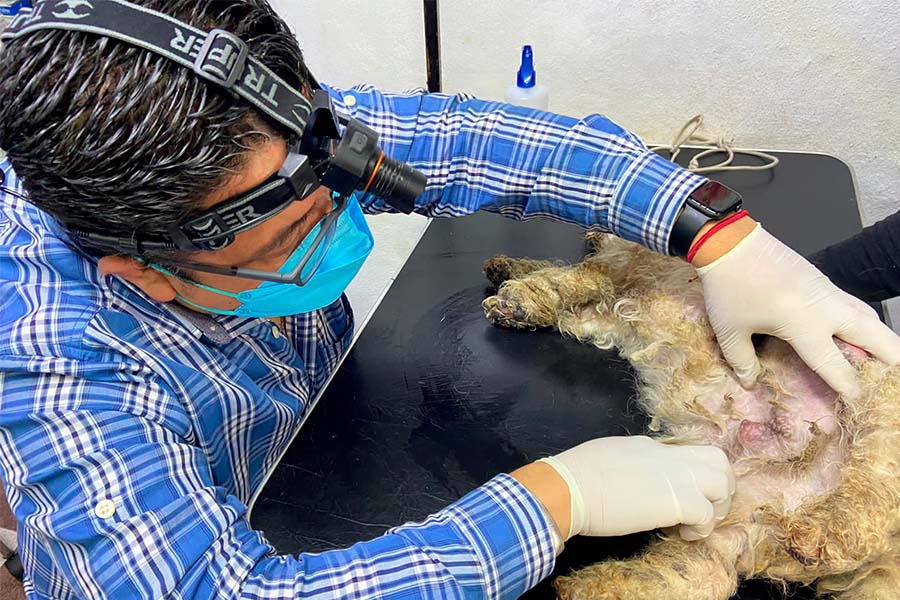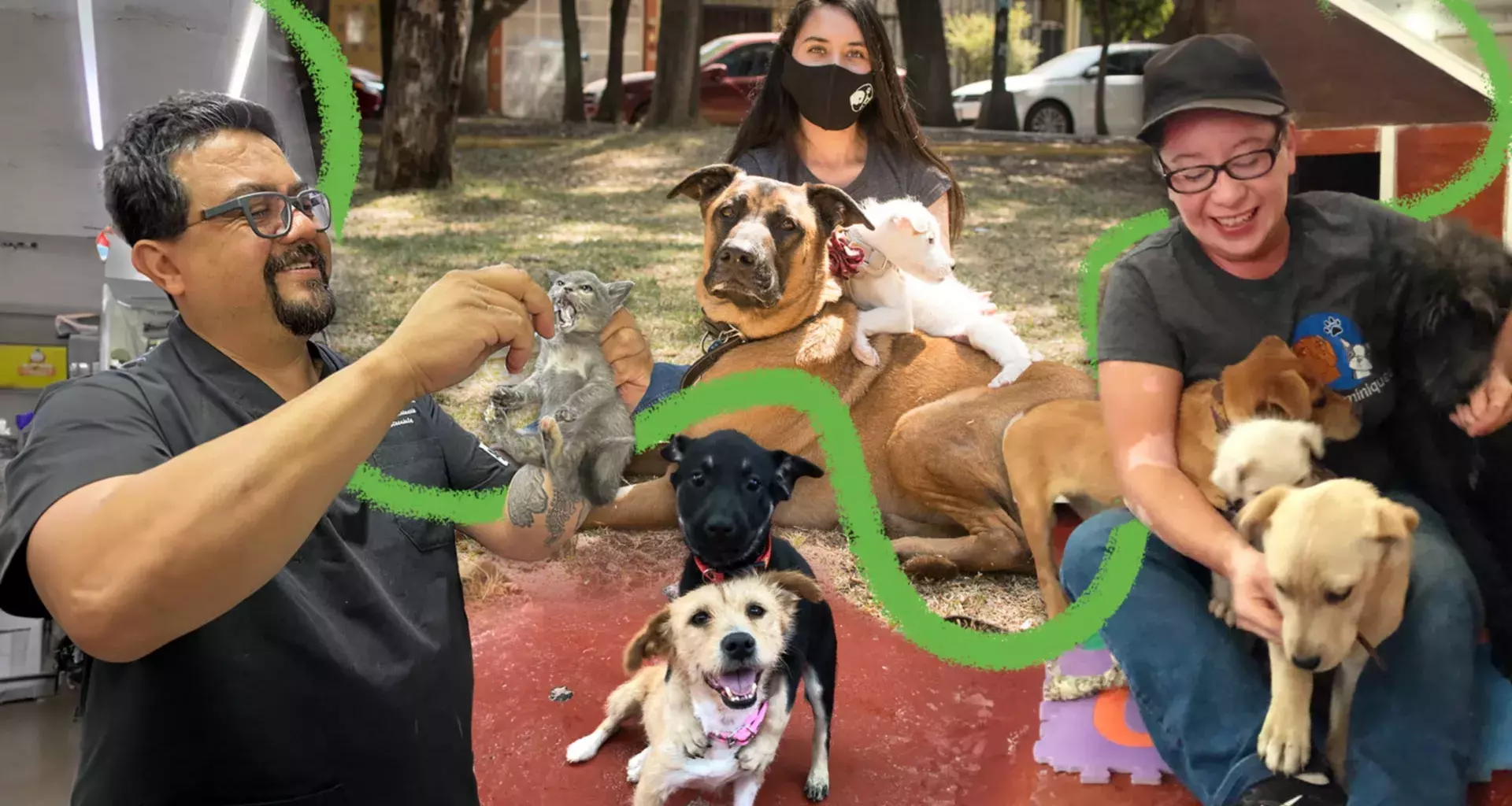“If you look closely, you can see I have some scars on the right side of my jaw. I was bitten by a large dog when I was three years old,” says Dominique Trejo, pointing at the scar.
The wound went deep. In fact, her parents were told she would need a lot of reconstructive surgery. Fortunately, the skin healed on its own.
“My parents didn’t want me to be afraid of dogs, so they took me to shelters from a young age as a form of therapy. I never felt any resentment over the attack, nor do I remember it, but the shelters strengthened my love for animals.”
Even when she started at Tec de Monterrey in Mexico City, she sold spicy chili apples to support shelters she knew.
The community knew of her work and approached her with some dogs that needed help, but the shelters didn’t have space, and she didn’t have the heart to leave them on the street.

A little green kennel and some chicken wire
“I couldn’t leave them on the street, so I started rescuing dogs on my own. The idea was to provide a foster home, but it got out of control after the fifth dog.”
She put up the dogs where she used to play when she was a child. The only thing left there was a swing. She lined it with chicken wire and used the structure to separate the dogs.
“It was already more than just a foster home, so I asked on social media for name ideas and a friend from high school suggested Dogminiquee. I loved it, and it stuck.”
“Stray dogs aren’t stray dogs; they’re everyone’s dogs.” - Dominique Trejo
The shelter began with a green kennel that is still standing today.
“I always say this is a Tec shelter because the school community is the one who supports it, donates to it, and adopts our animals.”
Everyone from managers to students’ younger siblings have taken in dogs and cats from Dominique’s shelter.
Donations were not enough
The first challenge the shelter faced was that there weren’t enough donations.
“I realized we weren’t going to survive on that alone, so I started selling pet stuff to meet our food and vet costs.”
A dog that comes in healthy and only needs vaccinations, de-worming, and sterilization costs approximately 3,000 pesos, but if it needs surgery, the cost can reach up to 10,000 pesos.
Dogminiquee has a sales booth at the Tec’s Mexico City campus. It is also supported by other Tec student ventures.
Mexico ranks number one in Latin America as the country with the largest population of stray dogs and cats, and ranks third for animal abuse, according to INEGI.
For example, a ciabatta stand donates one peso from each purchase. “The business grew, and I get income from it.” Like this one, other brands and ventures help support her.
She is also fortunate to be a former student of the veterinarian who treats the animals at the shelter and receives a discount on consultations and procedures. “The veterinarian is part of the shelter.”
In the beginning, they were not following any procedures for their rescues, but the veterinarian helped them establish rescue, rehabilitation, quarantine, and adoption protocols.

The hardest thing about a shelter is not rehabilitating and feeding
When Dominique and her mom thought everything was solved, they faced another problem: someone was using the shelter’s name and adoption forms.
“If the other place didn’t follow the procedures we have, the animals could spread diseases to people, and we would be held responsible.
During this crisis, the shelter received a grant to register the trademark with the Mexican Institute of Industrial Property (IMPI) and free help from a law firm. “This way, no one can use our name without consequences.”
“I always say this is a Tec shelter because the school community is the one who supports it, donates to it, and adopts our animals.”
They have also been accused of stealing animals, but they sought advice and learned how to file reports with the Public Prosecutor’s Office when a rescue involves a purebred animal.
“The hardest part of having a shelter isn’t having the animals, rehabilitating them, finding them homes and food. It’s nothing you would imagine. The most complicated thing is raising people’s awareness, trying to make them understand that what they’re doing is wrong.”
The most difficult cases Dominique has received come from homes, from families that have mistreated animals.
Stray dogs are not stray dogs; they’re everyone’s dogs
The shelter is divided up according to the animals’ size, age, and behavior. It has its own pharmacy, a separate quarantine area, a play area, and dormitories.
It has a maximum capacity for 30 dogs. When one is adopted, another one can take its place.
And the cats roam free in the Trejo family home, away from the dogs to avoid fights. Around 100 animals pass through the shelter each year.
There is also a very special space for those who don’t survive. “There are cases of animals that don’t survive, no matter how hard we try, so we hired a funeral home to cremate them.”
“Maybe they didn’t have a good life before, but here their ashes are in a special place. We set up an altar for them.” They go for walks in November, they are invited to fundraising events, and they went to march against animal abuse on June 25, 2023.
Mexico ranks number one in Latin America as the country with the largest stray dog and cat population, according to the National Institute of Statistics and Geography (INEGI).
In our country, 70% of dogs and cats are homeless, which is a population of over 16 million, almost the same as the number of people in the State of Mexico.
In addition, Mexico ranks third in Latin America for animal abuse, according to INEGI.
For Dominique, “stray dogs are not stray dogs, they’re everyone’s dogs,” and we should all take responsibility for them.

A sustainable shelter
Dominique studied Sustainable Development Engineering. Once her shelter was established, she wondered if she was helping the environment in any way.
“I realized I had already internalized it. Although we recycled everything, we made it official.”
She created “green footprints,” a program in which they clean up community spaces, collect garbage, separate it, and take it to recycling centers. The profits are used to pay for the veterinarian.
In addition, she has several programs to raise awareness among high schools, middle schools, and children.
Dominique is graduating this year. “I don’t know if I’ll continue to grow with the shelter or what will happen, but I’m very grateful for all the support I’ve received so far.”
There is no mark left from the scar that started it all, except for that of more than 400 dogs and cats that Dominique and her mom have rehabilitated, loved, and placed in new homes.
YOU’LL ALSO WANT TO READ:





